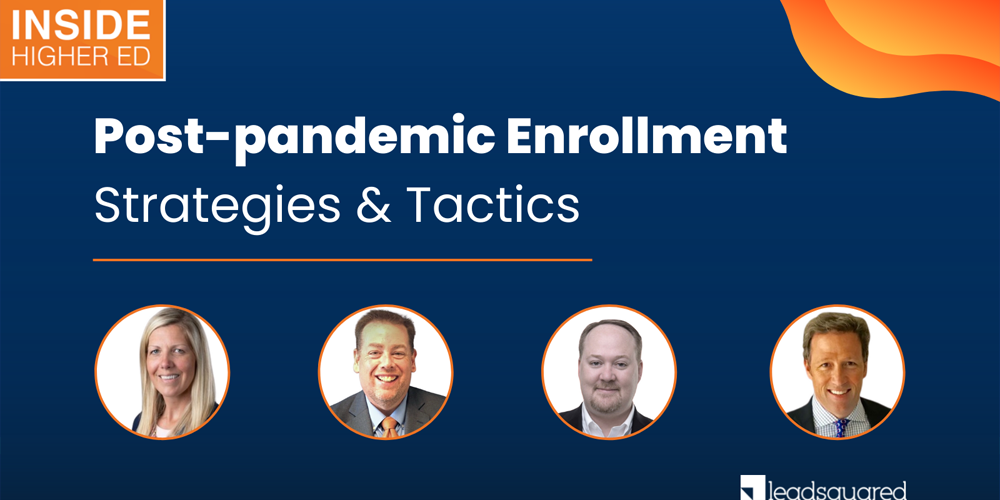Speakers:
- Mollie Cecere – VP, Enrolment Management and Corporate Partnerships, Carlow University
- David Eby – VP, Enrolment and Marketing, New England College
- Michael Graham – VP, Operations and Technology, National Louis University
- James Sparkman – Partner, Alpha Education
- Becky White – Sr. Account Executive, LeadSquared
Key Takeaways:
- Different universities saw different results in terms of decline and bounce-back rate post-covid.
- Investments from a marketing perspective and making people feel more like part of a community proved to be an effective strategy.
- Online prospects/automation played a significant role in providing endless opportunities for growth during and after the pandemic.
- Utilizing technology is one of the best ways to create efficiency and improve conversion rates.
The past few years have tested the resilience of virtually every industry. For higher education institutions, the tests have come in the form of new educational models, decreased enrollment, greater internal resource constraints, and more. It’s likely we will continue to see rippling effects from the pandemic for years to come, which means institutions must adapt to thrive. To address these persistent challenges, many institutions have adopted new processes and support from technology partners.
‘In the middle of difficulty lies opportunity’— Albert Einstein.
Finding opportunities that will allow for growth in the industry and of the industry is essentially what this webinar was all about.
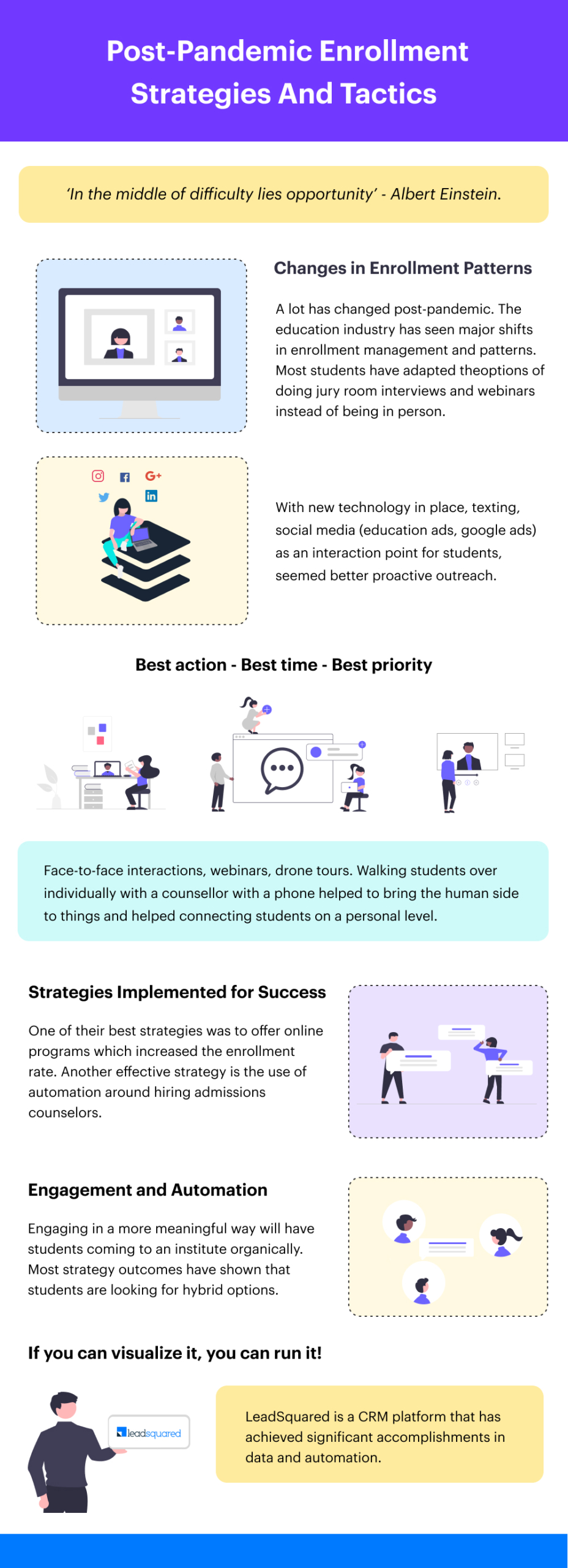
A lot has changed post-pandemic. The education industry has seen major shifts in enrollment management and patterns.
With an ambitious agenda at hand, James Sparkman starts the discussion, talking about how strategies for enrollment have changed after the pandemic.
The agenda includes
- Current enrollment results
- Post-pandemic strategies and tactics
- Technology adoption
- The future of marketing and recruiting
- Q&A
After a brief round of introduction of the panelists, James requested Mollie Cecere to share a little bit on her stand today as compared to pre-pandemic times.
Simultaneously, the first poll of the webinar is also posted for the audience. — “How is your campus doing at present?”
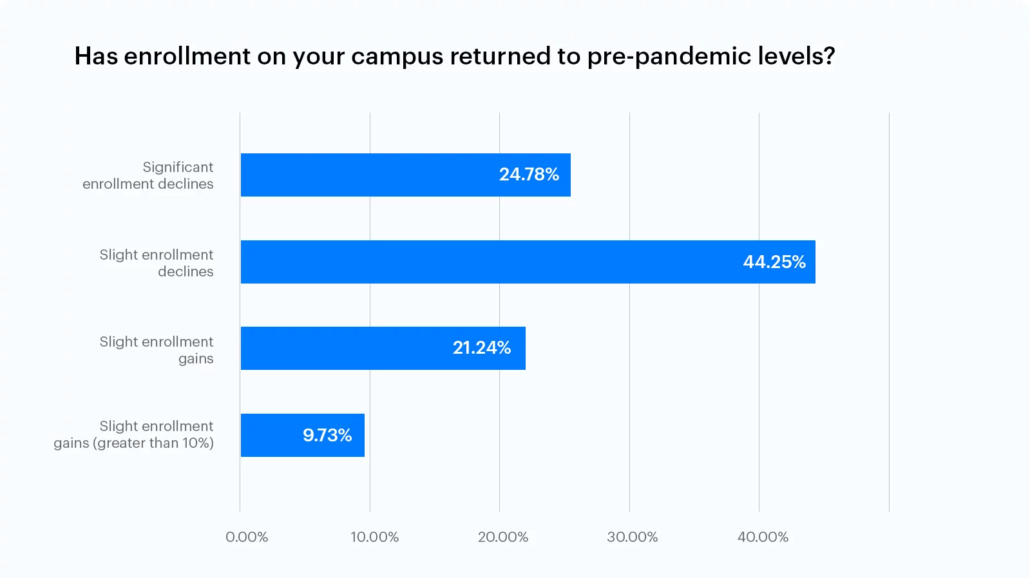
Poll results
Mollie then takes hold to describe how at the beginning of the pandemic, she and the institute were under the impression that everything would be back to normal in about two weeks, and it was after two weeks that they realized it would be a lot longer.
This resulted in an enrollment decline in new students.
However, there was a higher-than-normal retention rate. It might have been that many university students decided to stay put because of the uncertainty that was out there.
“Since the fall of 2020, we have continued to see enrollment growth. Fast forward to fall of 2022, we this year have welcomed our largest incoming class ever,” said Mollie about her institute’s current enrollment status before handing the conversation over to David.
David, on the other hand, saw some enrollment decline going into the fall of 2020.
“We were still below what we were seeing prior to the pandemic, especially with your traditional enrollment population.”
However, there was about 25 percent growth year over year from 2021 enrollments to 2022 with their traditional population. David stated that they have a very diverse population.
The institute also noted a bounce back in its international audience and online population as well.
Giving a final summary of his institute’s status pre and post-pandemic, David said, “while we are not back to where we were at with our traditional population, we are seeing some really good trends that are starting to bounce back. We saw growth from 2021 to 2022.”
Next, it was Michael’s turn to speak about his experience and institute.
“Ours was a little bit different,” he started.
For his university, at the beginning of the pandemic, the freshman enrollment stayed up, and he also saw an increase in retention.
In the last semester of remote, they saw a decline. However, they started to bounce back and were up significantly in the current semester.
“We start really late. Last week was our start week. Our president was smiling all week,” lightheartedly concluded Michael.
James then discussed the results of the poll that was conducted earlier.
About 70 percent of respondents said that they either saw slight declines or significant declines.
Key takeaway: Different universities saw different results in terms of decline and bounce-back rate. All of it is based on “where it is occurring and how it is occurring.”
Changes in Enrollment Patterns
James pointed out that all the institutes that had been discussed so far were “small,” in the sense they had less than 8 thousand students, and none of them had endowments to make big initiatives like North Carolina.
He also popped the second poll question for the audience before discussing the same with his fellow panelists—“Did you implement significant enrollment changes or recruiting changes?
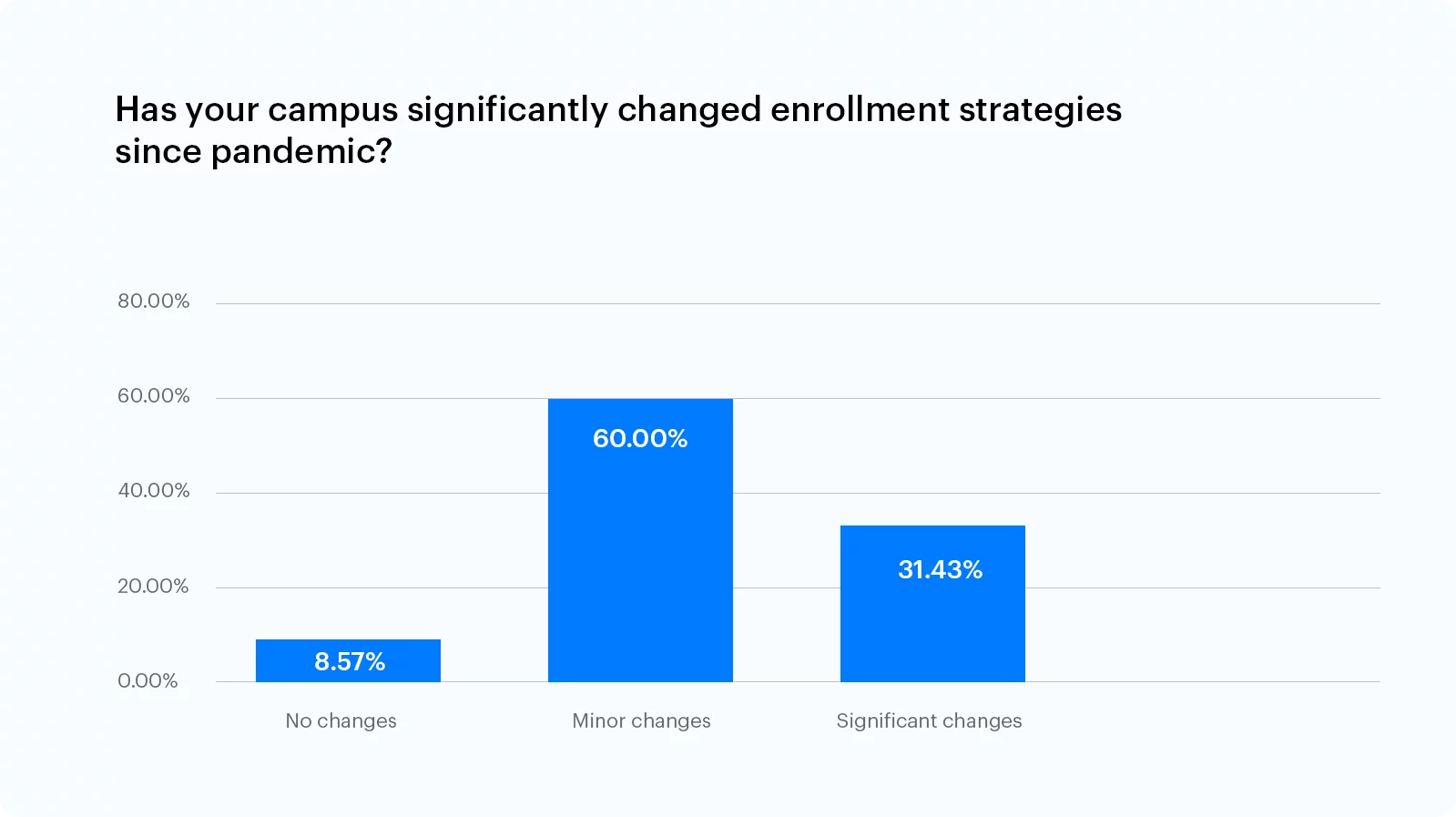
Poll results
David spoke first to take everyone through what New England College did to react to these changes and give ideas of things that did and didn’t work.
“One of the benefits of being a smaller institution is we are nimble and very entrepreneurial,” said David.
As an institute in the pandemic era, their first thought was how to meet their students where they were at.
They adapted to the most obvious options of doing jury room interviews and webinars instead of being in person, which helped quite a bit.
“We had to look at our entire communications strategy and how we were reaching out to students and the channels we were using to reach out to students.”
David’s strategy was simple enough. He saw that bringing a new system in place, and new technology, like text messaging and social media (education ads, google ads) as an interaction point for students, looked much more like a proactive outreach than before when they were a little more reactive.
For online and international audiences, they started doing a lot more webinars.
David, interestingly, was able to deduce that they were moving kind of slowly, and the pandemic put some fuel to that pace.
Michael spoke next about how they started using some of the same tactics around their retention. He said, “So we started text messaging. We started going after students to remind them to register at the start of the semester. Reaching out. I think that was a different thing that we had done that wasn’t necessarily new technology, but it was a new strategy.”
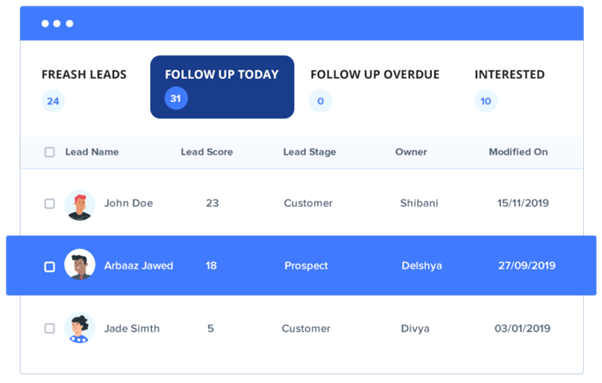
Best action, best time, best priority
He also added how in terms of new technology, the other thing they started doing was webinars.
Mollie took over next to talk about her strategies in enrollment.
She shared that her university did much of what the other panelists have already shared.
What really worked for them was face-to-face interactions. “We had to simply rely on video. So enhancing a virtual tour. Adding in drone tours. Walking students over individually with a counselor with a phone to show them this is exactly what the residence hall looks like,” she said.
This strategy helped them find a human side to things and connect to the student on a personal level.
What worked for them at Carlow was keeping that mix of both on-the-ground and online opportunities.
Key takeaway: The power move was to continue to make investments from a marketing perspective and make people feel more like part of a community, even if they are not on campus.
Strategies Implemented for Success
James held up the earlier poll results; less than 10 percent made no change, and 30 percent made significant changes.
The next topic of discussion was strategies implemented that were more than tactical change.
David shared that New England College more than doubled its investment online in the last two years.
“I would say the increase in investment and the awareness of the board of trustees to realize if we want to continue to remain viable long-term, we can’t continue to only rely on the traditional audiences,” he added.
Mollie also agreed and said how they committed to the pandemic at Carlow and were positioned well to scale their online offerings.
One of their best strategies was to offer online programs.
Students could work full-time and complete a program online, which helped them sustain their enrollment rate.
On the other hand, Michael’s strategy was an expansion of their portfolio.
“The strategy is about making small bets to try and see what will pay off and if it does double down,” he explained.
Talking about how technology and going online revolutionized their enrollment strategies, David rightly put forth that, “Now the pandemic forced us to figure it out. It is amazing what we can do on the other side.”
Key takeaway: Online prospects played a significant role in providing endless opportunities for growth during the pandemic and even after.
Engagement and Automation
Getting them that option or the choice they didn’t have before is what consumers or students expect.
There is always an internal push or pull on an on-ground institution.
Most strategy outcomes have shown that students are looking for hybrid options.
Engaging in a more meaningful way will have students coming to an institute organically.
David’s strategy was to “do more advertising and spend more money on social media to bring up brand awareness or awareness of our programs. It has probably been from a financial perspective the biggest significant change we have made in graduate recruitment.”
James put up another poll question for the audience at this point – “Did your support for international students change pre and post-pandemic? And did you consider full-time online enrollment?
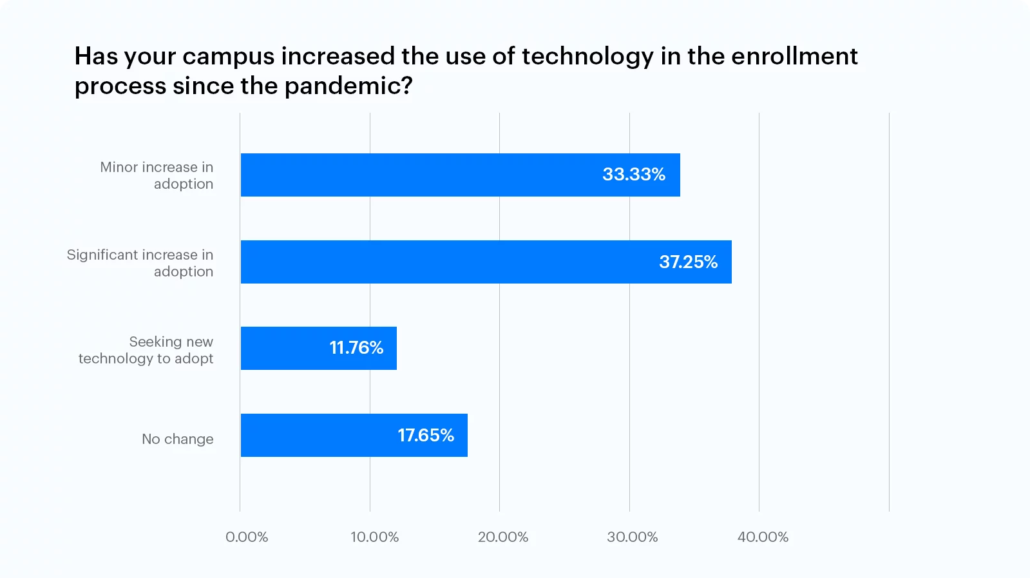
Poll results
“If you don’t put a focus on it, it won’t organically happen,” said David.
According to Michael, the biggest challenge was around recruiting.
Cecere put forth how Carlow did not have a significant international population. However, there was a need to build the right infrastructure and student support if that would be a potential growth area.
Talking about technology and its impact, Michael said that that had been their most significant investment because of the pandemic.
Creating automation in student communications was the need of the hour.
Automation had to be in place to ensure that institutes were responding quickly to inquiries and not just via a phone call but chat, text, and higher education email marketing options.
Explaining their success with automation, David said, “It required us to do an overall of our entire CRM. We implemented a new CRM through this process to help accommodate this for us. It has been very effective.”
The discussion then continued on OPMs and how they have benefitted several institutions during the pandemic.
Another effective strategy discussed was the use of automation around hiring admissions counselors.
An admissions counselor is an entry-level job at a university, and attracting people that are out there looking for jobs is a challenge.
Mollie’s solution to this was simple yet effective. “I think institutions have to be innovative and think differently. I also think you have to be authentically you and not try to be everything to everyone,” she said.
Fully utilizing the technology that is already paid for and that institutes have at their fingertips is one of the best ways to create efficiency and improve conversion rates.
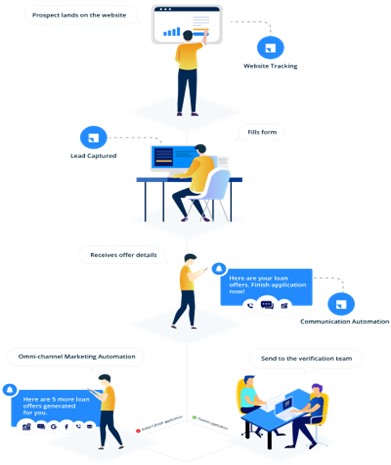
If you can visualize it, you can run it.
The discussion ended with a thought-provoking solution from David regarding marketing and enrollment.
The key is to communicate and keep everyone on the same page while going in the same direction.
LeadSquared is a CRM platform that has achieved significant accomplishments in data and automation. Book a demo for a tour today.
Speakers
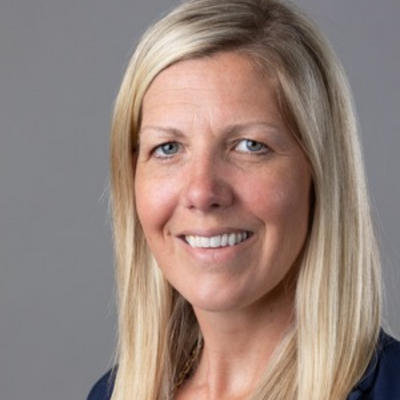
Mollie Cecere
Vice President for Enrollment Management and Corporate Partnerships -Carlow University
Mollie Cecere is an executive with over 20 years of experience in higher education including enrollment management, financial aid, retention, and marketing. She is the Vice President of Enrollment Management and Corporate Partnerships at Carlow University, a small private liberal arts institution located in Pittsburgh. Under her leadership, Carlow has experienced growth across adult and graduate student segments through a commitment to supporting the adult learner. Prior to Carlow, Mollie served as the Vice President for Enrollment Management and Student Success at Bethany College.
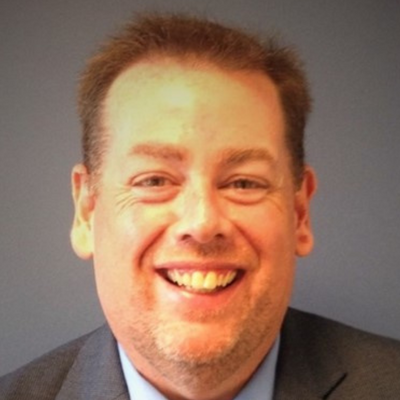
Michael Graham
Vice President, Operations and Technology – National Louis University
Michael Graham (Ed.D.) is Vice President of Operations and Technology at National Louis University where he is responsible for enhancing operational efficiency, supporting academic and administrative technology, as well as instructional design and online programming. He has been at National Louis University for the past 11 years where he has been responsible for helping the university modernize its infrastructure, re-engineer NLU’s undergraduate experience, and led the transition of Kendall College during its acquisition by National Louis University. Mike holds a B.A. and an M.A. in History from Youngstown State University and a Doctorate in Education from National Louis University. His research interests span the rise and change of online program management organizations, as well as leadership and operational efficiency as information technology and academic affairs continue to collide in higher education.

David Eby
Vice President of Enrollment and Marketing – New England College
David Eby has over 20 years of experience in higher ed marketing, admission, and operations leadership. Over the last three years, his work has led him to work with multiple universities to help them navigate through the pandemic by helping them transition to a virtual learning environment. Prior to the pandemic, David was the COO for the coding boot camp startup, Thinkful, where he helped lead them to acquisition by Chegg in under one year of service. One of his more recent roles in higher ed was serving as COO for Grantham University, where he was responsible for positioning the university for acquisition (now a part of the University of Arkansas). Prior to that role, he worked with Bertelsmann Education Group in a variety of roles, including Chief Academic Success Officer for HotChalk, President of Arist Learning Solutions, and Chief Marketing Officer for Arist Education System.

James Sparkman
Partner – Alpha Education
James Sparkman currently leads a national practice representing colleges and universities exploring long-term private-sector partnership opportunities. Prior to founding Alpha Education, James spent a decade as an investor, advisor, and senior executive working with a range of postsecondary education companies. Previously, James was the co-founder of HigherMarkets, a venture-backed university SaaS company that was acquired by SciQuest (now Jaggaer). James also held early executive roles at private equity firm New Mountain Capital and student lender First Marblehead (now Cognition Financial). James began his career as a public school teacher in Brooklyn, NY, where he was a member of the first class of Teach For America. James received his B.A., cum laude, from Middlebury College and his M.B.A. from Harvard Business School.







